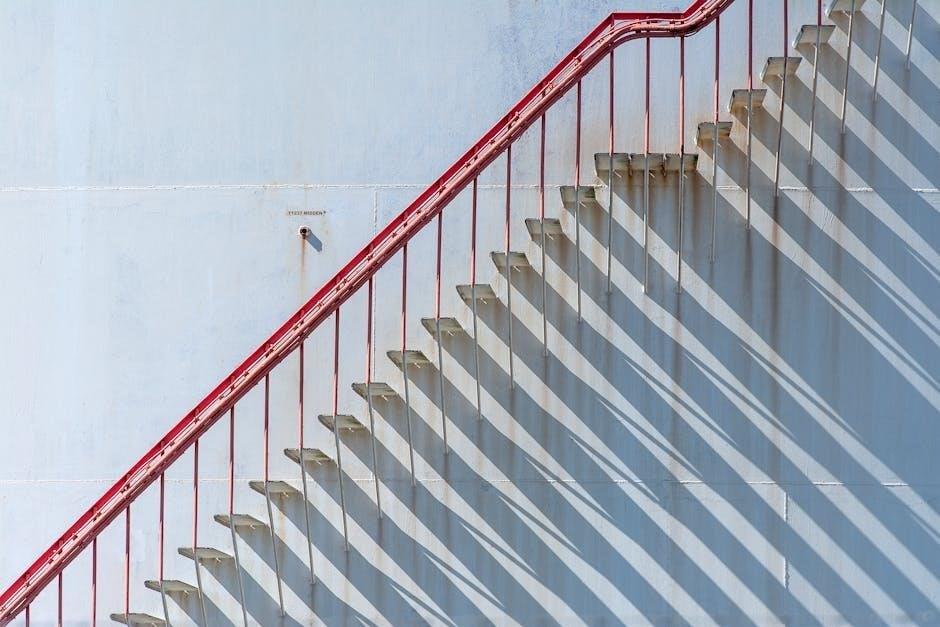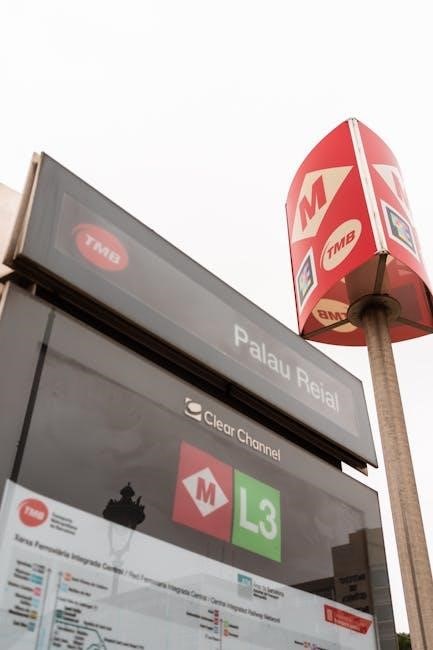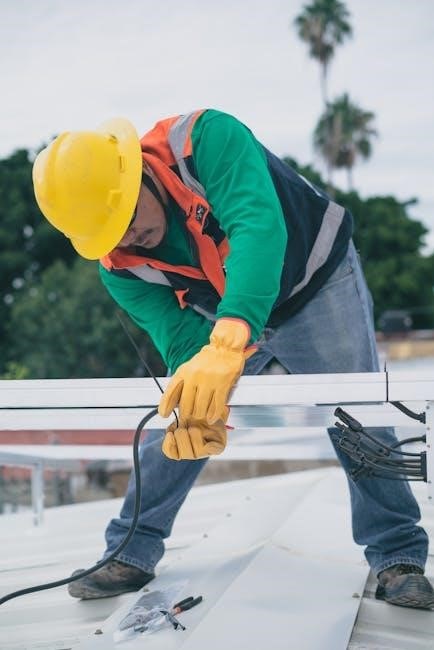Purpose of the Guide
The purpose of the HardiePlank installation guide is to provide a comprehensive resource for installers, contractors, and homeowners to ensure a successful and proper installation of HardiePlank products․ This guide is designed to be a step-by-step manual that outlines the necessary procedures and best practices for installing HardiePlank cladding, including preparation, installation, and maintenance․ By following the guidelines outlined in this document, users can ensure a high-quality installation that meets the manufacturer’s standards and warranties․ The guide is intended to be used in conjunction with local building codes and regulations, and it is recommended that users review and comply with all applicable laws and standards․ Overall, the purpose of the guide is to provide a clear and concise resource for installing HardiePlank products, and to help users achieve a professional-looking and durable finish․ The guide is an essential tool for anyone looking to install HardiePlank products․

Pre-Installation Requirements
Pre-installation requirements include checking local building codes and regulations carefully
Review of Installation Instructions
A review of the installation instructions is crucial before starting the project․ The instructions provide detailed information on the installation process, including the preparation of the site, the handling of materials, and the actual installation of the HardiePlank․ It is essential to read and understand the instructions carefully to ensure a successful installation․ The instructions are available on the James Hardie website and can be downloaded in a PDF format․ They include diagrams, illustrations, and step-by-step guides to help installers understand the process․ The instructions also cover topics such as safety precautions, tool requirements, and troubleshooting․ By reviewing the installation instructions, installers can identify potential issues and take necessary precautions to avoid them․ This helps to ensure a smooth and efficient installation process, and ultimately, a high-quality finish․ The review of the instructions is an important step in the installation process, and it should not be overlooked․ Proper installation is critical to the performance and durability of the HardiePlank․

Types of HardiePlank Installation
HardiePlank installation types include various methods and techniques available
Horizontal Installation
Horizontal installation of HardiePlank is a popular method used for exterior cladding․ This type of installation involves overlapping the planks to create a watertight seal․ The planks are typically installed from the bottom up, with each plank overlapping the one below it․ This method is suitable for most exterior walls and can be used with a variety of flashing details․ The horizontal installation method is also relatively easy to install, making it a popular choice among contractors and homeowners․ Additionally, this method allows for easy replacement of damaged planks, as each plank can be removed and replaced individually․ The horizontal installation method is also compatible with a range of finishing trims and moldings, making it a versatile choice for exterior cladding․ Overall, the horizontal installation method is a reliable and efficient way to install HardiePlank, providing a durable and long-lasting exterior cladding solution․ Proper installation is crucial to ensure the longevity of the product․
Vertical Installation
Vertical installation of HardiePlank is a unique method that involves installing the planks in a vertical orientation․ This type of installation is often used to create a distinctive and modern look, and can be used to add visual interest to a building’s exterior․ The vertical installation method involves installing the planks from the bottom up, with each plank butted up against the one above it․ This method requires careful planning and execution to ensure a watertight seal, and may require additional flashing details to prevent water infiltration․ The vertical installation method can be more challenging to install than the horizontal method, but can create a dramatic and eye-catching exterior finish․ With proper installation and maintenance, a vertical HardiePlank installation can provide a durable and long-lasting exterior cladding solution․ The use of vertical installation can also help to create a sense of height and grandeur, making it a popular choice for modern and contemporary building designs․ Proper flashing and sealing are crucial to prevent water damage․

HardiePlank VL Installation
HardiePlank VL installation requires specific techniques and tools always
VL Horizontal Installation
To begin with, the VL horizontal installation process involves several key steps, starting with the preparation of the wall surface․
The installer must ensure that the surface is clean, dry, and free of any debris or obstacles that could interfere with the installation․
Next, the installer must measure and mark the location of the first course of VL panels, taking care to align them properly with the surrounding surfaces․
The VL panels are then installed, overlapping each other to create a watertight seal, and secured in place using the recommended fasteners․
It is essential to follow the manufacturer’s instructions for the installation of VL panels to ensure a successful and durable installation․
The installer must also pay attention to the spacing and alignment of the panels to achieve a professional-looking finish․
By following these steps and guidelines, the VL horizontal installation process can be completed efficiently and effectively, providing a high-quality finish that meets the required standards․
The installation process requires patience, attention to detail, and a thorough understanding of the manufacturer’s instructions․
VL Vertical Installation
The VL vertical installation method is a popular choice for many builders and homeowners due to its unique appearance and durability․
This method involves installing the VL panels in a vertical orientation, which can add a touch of elegance and sophistication to any building․
The installation process for VL vertical panels is similar to the horizontal method, but with some key differences․
The panels are installed from the bottom up, with each panel overlapping the one below it to create a watertight seal․
The installer must ensure that the panels are properly aligned and spaced to achieve a professional-looking finish․
The use of vertical installation can also help to create a sense of height and grandeur, making it a popular choice for modern and contemporary designs․
By following the manufacturer’s instructions and taking the necessary precautions, the VL vertical installation process can be completed successfully and efficiently, providing a high-quality finish that meets the required standards and regulations․
The result is a durable and long-lasting exterior finish that requires minimal maintenance․

Maintenance and Warranty
Maintenance and warranty information is crucial for homeowners to understand
Maintenance Requirements
To ensure the longevity of HardiePlank, regular maintenance is necessary․ This includes inspecting the siding for any damage or wear, cleaning it with a mild detergent, and repairing any damaged sections․ Homeowners should also check for any gaps or cracks in the siding and seal them to prevent water damage․ Additionally, it is recommended to trim back any trees or shrubs that are in contact with the siding to prevent damage from branches or roots․ By following these maintenance requirements, homeowners can help extend the life of their HardiePlank siding and keep it looking its best․ Regular maintenance can also help to identify any potential issues before they become major problems, saving homeowners time and money in the long run․ A well-maintained HardiePlank siding can provide years of protection and beauty to a home․ Proper maintenance is essential for the durability of the siding․
Warranty Information
James Hardie provides a warranty for their HardiePlank products, which covers defects in materials and workmanship․ The warranty period varies depending on the specific product and installation location․ It is essential to review the warranty document to understand the terms and conditions․ The warranty information can be found on the James Hardie website or by contacting their customer service department; Homeowners should keep a copy of the warranty document and the installation receipt, as these may be required to make a claim․ The warranty provides peace of mind for homeowners, knowing that they are protected in case of any issues with the product․ By registering the product, homeowners can also receive additional benefits and support․ It is crucial to follow the installation instructions and maintenance requirements to ensure the warranty remains valid․ James Hardie’s warranty is a testament to their confidence in the quality of their products․ The warranty information is subject to change, so it is essential to check the James Hardie website for the most up-to-date information․



